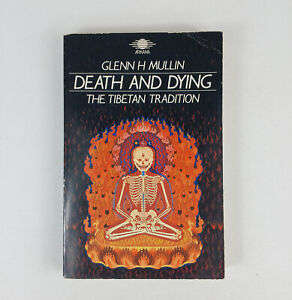
Death and Dying: The Tibetan Tradition
Check my rate
| Main centres: | 1-3 business days |
| Regional areas: | 3-4 business days |
| Remote areas: | 3-5 business days |

| Main centres: | 1-3 business days |
| Regional areas: | 3-4 business days |
| Remote areas: | 3-5 business days |
Arkana, 1987, softcover, index, 251 pages, condition: as new.
Over the centuries the Tibetans have developed a wide-ranging literature on death, including inspirational poetry and prose, occult texts, prayers, mysticism and practical works on care for the dying. This book draws on nine Tibetan texts - including the famous "Tibetan Book of the Dead" - written by Tibet's spiritual authorities. It covers topics such as meditation techniques to prepare for death, inspirational accounts of the deaths of saints and yogis, methods to facilitate the transition to new modes of consciousness and a clear introduction that explains the concepts of karma and re-incarnation.
A FINE SUMMARY OF TIBETAN BUDDHIST TEACHINGS ON THESE TOPICS
Glenn Mullin has been an international teacher of Tantric Buddhist meditation for more than twenty-five years. He lived in Dharamsala, India, for fifteen years, studying under many masters of Tibet, including the Dalai Lama and his two main gurus. In 1986 he formed The Mystical Arts of Tibet Inc., which brought Tibetan monks to North America to perform sacred music and dance, and create sacred sand mandalas.
He wrote in the Acknowledgements section of this 1986 book, The present volume is an attempt to give the Western reader a glimpse of the breadth and nature of these. It grew out of my twelve years of study and research at the Library of Tibetan Works and Archives, Dharmasala, and my experiences in the Tibetan refugee communities in India.
He states in the Introduction, The subject of death has fascinated mankind from time immemorial, ever since his intelligence developed to the point where he would realize that the laws of impermanence, so obvious in the environment around him, also applied to his own stream of being. Yet like all things that make a strong statement to us but provoke more questions than ready-made answers, our response to the constantly pressing reality of death has changed with the trends of the passing centuries. Thus we have seen great civilizations, such as that of Egypt, with entire religious traditions centered on the concept of death Our own age, on the other hand, has constantly attempted to gloss it over. The decline of religion resulted in death and dying being taken out of the community and placed in the hands of professionals (Pg. 1-2)
He explains, Within the diverse orders of Tibetan Buddhism there of course exist philosophical and doctrinal differences, but the essential substance of each of the traditions is the same. All are based on Buddhas Hinayana teachings of the four noble truths and three hither trainings, the Mahayana teachings on the cultivation of the Bodhisatva aspiration and the six perfections, and the Vajrayana methods of the four tantric paths. The differences lie more in the manner of expression of these teachings---each lineage developed at a different time and in a different part of the country, thus having aspirations in language and style. But each of the sects advocate the applications of all three yanas, while emphasizing different aspects of the teachings and giving slightly different philosophical interpretations to the various scriptures. (Pg. 12)